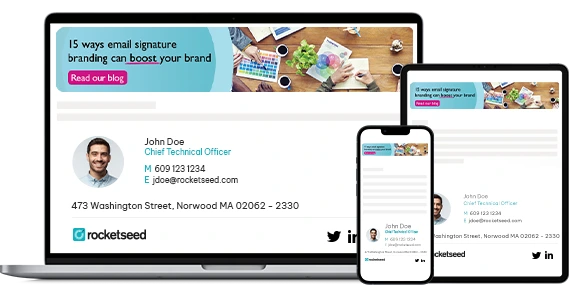
Faced with so many challenges, competitors, consumer choices and marketing channels, a controlled, consistent corporate brand is essential to your business’s success (and even its survival) more than ever before. But, in a climate of targets and time pressures, it’s easy to lose sight of.
That’s why, in this blog post we’re going ‘back to basics’ with corporate branding to help your business make a positive, authentic, emotional and memorable connection with your customers who are paying more attention to corporate branding than ever before.
Along the way, we’ll also show how your business email signature can help meet your corporate branding goals.
What is corporate branding?
Whilst there are a huge variety of definitions, The American Marketing Association says…
“A brand is a name, term, design, symbol or any other feature that identifies one seller’s goods or service as distinct from those of other sellers”
Corporate branding is how a company promotes its brand name, identity and message, in contrast to solely focusing on the products or services it sells. But it’s so much more than that… it’s the philosophy and values on which the business is built and how these are communicated to make an emotional connection with its stakeholders and to target relevant customers.
There can also be a lot of brand jargon to navigate (so, like us, you’ll find the Branding Glossary from How Brands Are Built extremely helpful.)
Why is corporate branding important?
Social media and the digital consumer space have played a critical part in the importance of corporate branding for businesses. Customers digest more information about companies than ever before, and the demand for transparency is rising rapidly. Customers care about what corporate brands represent, so it’s vital to make corporate branding a fundamental part of business strategy.
How to create a corporate branding strategy
The corporate branding process enables businesses to develop a consistent and transparent identity in the market. There are several steps to take, which ensure your message is authentic and communicated appropriately to your target audience.
Take a look at this branding checklist from Theresa Depasquale to get you started.
Look deeper at your audience and identify your customers
People are pickier than ever when it comes to choosing where to buy products and services. Long gone are the days of the ‘one size fits all’ offer. With a clearly defined target customer audience, you can hone in on your branding and messaging. Consumers want to feel immersed in a brand and see that it fits their lifestyle. Do this effectively and you’ll get better conversions and a loyal following. We found these 5 Steps to Identify Your Ideal customer from Audience Ops helpful when we were developing our ICP (Ideal customer profile).
Themba Nkuna, a South African sales coach, author and speaker stated that understanding your customer is the new competitive advantage:
Show authenticity
The branding buzz-word of our times – ‘authenticity’. It’s about connecting with people through your brand’s back-story, heritage and core values. The trick is in bringing a human touch to your corporate branding through messaging that sparks emotion and conversation. Use everything from your ‘About Us’ page to your email marketing strategies to speak directly to your customer. Just because you are interacting with your customers through technology and screens, it shouldn’t mean the human interaction and touch disappears. Tyllah, @MarketingBully_, advocates for authentic branding on Twitter:
Content tip of the day:
Be you.
Don’t follow trends that don’t fit your brand.
Don’t mimic what other brands do, that doesn’t mean it’ll work for you.
Be you.
Develop your brands personality.
Personify your brand, create your own lane and be you.
Authenticity matters.
— Tyllah | Email Marketing Specialist (@MarketingBully_) February 5, 2022
Be more than a logo
That’s not to say your logo isn’t important. It’s a vital part of your brand identity (and the starting point of most email signature designs!). The most successful brands though are more than just a well-known logo. Show your customers the brand behind the logo. People want to see what brands can do outside the parameters of products and services. Show your values and share your passions as it creates a personality and brand purpose.
Successful corporate branding ideas
Once you’ve established the foundations, it’s time to develop corporate branding ideas.
Look at your current corporate branding
Has your business’s brand moved with the times or stayed still for years? The first step in changing it is to look at what you already have. Start by auditing every aspect of your branding, including marketing and visuals. Ask yourself whether your identity matches your overall messaging. In many cases, this will highlight any inconsistencies that you can work on changing.
When auditing your corporate branding, your business email signatures can be quite revealing. Does your brand logo look up to date? Are you featuring your social media channels? Are you missing opportunities to feature a bold brand statement or link to branded content?

Try something new
Many brands are dubious about trying something completely new, but it can be a game-changer. Look at your current industry and identify where you can fill the gaps. Brands don’t have to go ‘all-out’ to differentiate themselves. Look at simple changes such as redesigning your website or creating an app. Or perhaps overhaul your customer services with more innovative ways of engaging with customers, say email banners on your everyday email.
If you’re looking for some brand-building email banner inspiration, take a look at our 33 Great Email signature Banner Examples.
Show you care
You really can’t afford to overlook your brand’s social responsibility. Customers want their favourite brands to share their values so you need to introduce a corporate social responsibility plan in your company. There are many ways brands can give back to the community both on local and national scales, from charity events and community projects to educational and environmental initiatives. But be sure to be authentic as there’s a huge price to pay for contradicting your own corporate brand values!
All on the same page
For effective corporate branding you need everyone to be on-brand, from the CEO to the newest recruit, from sales and marketing to HR and operations. And that means building a strong corporate culture – ‘the way we do things here’. From onboarding and team-building to your everyday communications and work environment, use every opportunity to strengthen your company culture through ‘internal marketing’ – a task that internal email banners can help with.
Keep in control
If you want consistent corporate branding, you need to keep every element under control. Whose job is that? Do you have a Head of Brand, maybe it’s your marketing head? Whoever it is, it’s all about ensuring a clear, consistent brand message across your business and to all your stakeholders.
For a consistent brand on email company-wide, the solution is simple – centralized control.
The benefits of corporate branding for businesses
Naturally, there are several benefits of successful corporate branding. Some examples include:
- Improved awareness and recognition in the public eye
- Easier customer purchase decision-making
- Customer retention and loyalty
- Attract and retain talented staff throughout the company
- Increased productivity as everyone is on the same page
- Clear and consistent internal decision-making
- Stronger negotiating powers
- Opportunities for innovation and growth increase
- Improved relationships with the media and government institutions
These are just a few benefits of developing a corporate branding strategy, and the investment is substantially worth the time and input needed to create streamlined processes. Alice Pettey recently highlighted the benefits of brand strategy and identity on her Business, Branding and Life podcast.
Listen to “2 – Benefits of Brand Strategy & Identity” on Speaker.
Corporate branding helps define your business and delivers everything your customers are looking for. Don’t forget this is an ever-evolving business strategy, and what works well now may not in a few years. Keep learning and innovating with your audience to keep your brand responsive and relevant.
Best resources about corporate branding
- Brandingmag: The original branding magazine, featuring branding thought leadership from across the globe.
- How Brands are Built: A blog and podcast where branding professionals get into the detail of what they do and how they do it.
- Branding Strategy Insider: A leading source of inspiration and innovation, giving readers key insights into the critical areas, tools and techniques shaping brand management.
- BP&O: One of the longest running design blogs to offer a unique view on the very best in branding.
- Branding Nerd: A blog site aimed at placing the spotlight on brilliant ideas that brands have executed anywhere in the world.
Need to brand your business email?
Businesses across the globe trust Rocketseed to give them clear, consistent corporate branding on every email their employees send. Our case studies are full of creative corporate branding examples and to see how we can help you build your brand on email today simply contact us for a personalized demo.
Shanique Brophy | Marketing Executive
Connect with Shanique on LinkedIn





Utilize social media
Social media marketing should be a fundamental aspect of any corporate branding strategy. It’s one of the best places to interact and engage with customers and puts a person behind the brand. It can be hard work continually creating new unique content, responding to reviews or promoting and hosting webinars but it pays off in brand profile and engagement. You need a consistent brand image across all your social marketing channels and your email signature can be your link to social success.